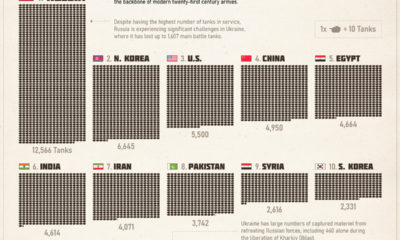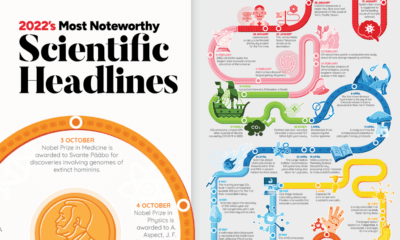Yet, today’s interactive data visualization from Overflow Data shows that America’s confidence in institutions has drastically waned. The data relies on the General Social Survey (GSS) to provide a 40-year overview of how sentiment has changed with respect to 13 different institutions. Select an institution from the drop-down menu below to see how confidence has changed over time
The Erosion of Confidence
Overall, confidence in most institutions has eroded. Americans find it especially hard to trust their government: the “great deal of confidence” metrics for Congress, the Supreme Court, and the Executive Branch were low to begin with, and have declined further since 1975. That said, the biggest overall drop belongs to the press, which saw 50% of surveyed Americans saying they have “hardly any confidence” in it in 2016. This is nearly a three-fold increase from 1975, when that number was just 19%. Of course, with the rise of fake news in more recent years, the erosion of confidence in media doesn’t seem to be slowing down. Here’s a look at the two extremes of sentiment regarding the studied institutions, showing how the opposite measures of “hardly any confidence” and a “great deal of confidence” have changed since 1975: Banks and financial institutions have also suffered a bad rep in the public eye. Their “great deal of confidence” metric has dropped sharply from 32.3% to 14.1% in four decades. One major exception is the military, which emerges as the most trusted institution. Americans’ faith in the military has also shown the most improvement, with a 17.1 p.p increase in a “great deal of confidence” since 1975.
The Split Widens Further
While measuring public confidence in institutions can be subjective, it provides an understanding of where Americans want to see change and reform take place. For more on how Americans perceive different institutions and the issues that affect them, see how the public is divided based on political affiliation. on Even while political regimes across these countries have changed over time, they’ve largely followed a few different types of governance. Today, every country can ultimately be classified into just nine broad forms of government systems. This map by Truman Du uses information from Wikipedia to map the government systems that rule the world today.
Countries By Type of Government
It’s important to note that this map charts government systems according to each country’s legal framework. Many countries have constitutions stating their de jure or legally recognized system of government, but their de facto or realized form of governance may be quite different. Here is a list of the stated government system of UN member states and observers as of January 2023: Let’s take a closer look at some of these systems.
Monarchies
Brought back into the spotlight after the death of Queen Elizabeth II of England in September 2022, this form of government has a single ruler. They carry titles from king and queen to sultan or emperor, and their government systems can be further divided into three modern types: constitutional, semi-constitutional, and absolute. A constitutional monarchy sees the monarch act as head of state within the parameters of a constitution, giving them little to no real power. For example, King Charles III is the head of 15 Commonwealth nations including Canada and Australia. However, each has their own head of government. On the other hand, a semi-constitutional monarchy lets the monarch or ruling royal family retain substantial political powers, as is the case in Jordan and Morocco. However, their monarchs still rule the country according to a democratic constitution and in concert with other institutions. Finally, an absolute monarchy is most like the monarchies of old, where the ruler has full power over governance, with modern examples including Saudi Arabia and Vatican City.
Republics
Unlike monarchies, the people hold the power in a republic government system, directly electing representatives to form government. Again, there are multiple types of modern republic governments: presidential, semi-presidential, and parliamentary. The presidential republic could be considered a direct progression from monarchies. This system has a strong and independent chief executive with extensive powers when it comes to domestic affairs and foreign policy. An example of this is the United States, where the President is both the head of state and the head of government. In a semi-presidential republic, the president is the head of state and has some executive powers that are independent of the legislature. However, the prime minister (or chancellor or equivalent title) is the head of government, responsible to the legislature along with the cabinet. Russia is a classic example of this type of government. The last type of republic system is parliamentary. In this system, the president is a figurehead, while the head of government holds real power and is validated by and accountable to the parliament. This type of system can be seen in Germany, Italy, and India and is akin to constitutional monarchies. It’s also important to point out that some parliamentary republic systems operate slightly differently. For example in South Africa, the president is both the head of state and government, but is elected directly by the legislature. This leaves them (and their ministries) potentially subject to parliamentary confidence.
One-Party State
Many of the systems above involve multiple political parties vying to rule and govern their respective countries. In a one-party state, also called a single-party state or single-party system, only one political party has the right to form government. All other political parties are either outlawed or only allowed limited participation in elections. In this system, a country’s head of state and head of government can be executive or ceremonial but political power is constitutionally linked to a single political movement. China is the most well-known example of this government system, with the General Secretary of the Communist Party of China ruling as the de facto leader since 1989.
Provisional
The final form of government is a provisional government formed as an interim or transitional government. In this system, an emergency governmental body is created to manage political transitions after the collapse of a government, or when a new state is formed. Often these evolve into fully constitutionalized systems, but sometimes they hold power for longer than expected. Some examples of countries that are considered provisional include Libya, Burkina Faso, and Chad.














